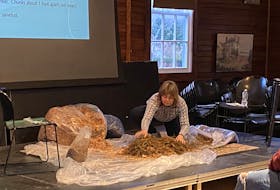A private pointed his rifle at the man but the corporal told him not to shoot until he could confirm it was a German enemy.
“Who goes there?” called out the corporal.
“Butler,” came back the reply from the approaching man.
Capt. Bertram Butler had been out all night, as close to the enemy’s trenches as he could get, gleaning information about the German position.
He only made his way back when he thought the dawning day would reveal him to the enemy.
This was just one of the daring initiatives Butler was known to regularly undertake as one of the leaders of the Royal Newfoundland Regiment in the First World War.
It’s an example of why the accountant from Topsail, who would move to Corner Brook after the war and live his life out there, became the regiment’s most decorated First World War soldier.
After the war, he would be promoted to the rank of major and continue to serve in many ways, though away from the fierce battlefields.
Gus Cossitt, a veteran of the Second World War from Corner Brook who served as a merchant marine, remembers the older war hero well. He also heard the many stories of Butler’s daring feats in battle.
“They’d get into a German trench and they did one of two things: either kill them or take them prisoner,” said Cossitt, who turns 89 in July. “He brought back a lot of information for the regiment.”
The Raids at Beaumont Hamel
In the days leading up to the infamous Battle of Beaumont Hamel, where the Royal Newfoundland Regiment’s numbers were dreadfully decimated July 1, 1916, Butler led a series of raids on the German trenches to assess the enemy’s preparedness in advance of the planned attack.
The first raid on the night of June 26, 1916, failed when the Germans were alerted to the approach of Butler and his men. They were forced to retreat, suffering just two minor casualties.
The following night, despite heavy rains, Butler ordered another raid. This time, they got within 20 yards before a fierce firefight ensued, with both sides suffering heavy casualties.
All three officers in the raiding party, including Butler, were among the 21 soldiers wounded. Four of their men were killed and two more later died of their wounds.
Three others were taken prisoner by the Germans.
The raid was considered a success, though, because it was able to determine the German trenches were intact and the wire on the German front line was thick and unbroken.
The intelligence gathered reportedly went ignored by those higher in command, but Butler was later awarded the Military Cross for his role in the raids leading up to Beaumont Hamel.
Though wounded in the raids, Butler remained at his duties and also took part in the ill-fated attempt to take the German line at Beaumont Hamel.
In a letter he would write to the regiment’s pay and record office on July 3, 1916. Butler indicated his wounds were not serious.
“Injuries very slight,” he wrote. “Don’t worry.”
According to the Royal Newfoundland Regiment Museum, awards for gallantry were deliberately not awarded for the events of July 1, except for some given to the medics who risked their lives to save others. This was a calculated decision to demonstrate that the action of the entire battalion that day was a display of gallantry not carried out by just a small group from their ranks.
Gueudecourt
The raids leading up to the Battle of Beaumont Hamel would not be Butler’s only distinguished accomplishment during the Battle of the Somme.
In October 1916, he would earn the Bar to the Military Cross for his role in the Battle of Gueudecourt. Butler and the Royal Newfoundland Regiment were part of a creeping barrage that involved hand-to-hand fighting with the German forces before the Allies eventually won the objective.
Butler would go on to write an account of the gruesome battle for the June 1922 edition of The Veteran magazine.
“Many of our men used a bayonet to kill for the first time, and when once they got the ‘knack’ of it, it was hard to make them give it up,” he would write.
According to the regiment’s archived accounts of the Battle at Gueudecourt, the Allies killed around 250 German soldiers.
Butler himself is said to have dispatched 15 of them. According to the Daily Orders published by the London Gazette shortly after the battle, Butler “showed the greatest personal courage in the attack on German trenches and, by his able dispositions, consolidated the position and held it against counterattacks.”
Wounded
Butler would serve on the battlegrounds with the regiment for nearly the entire First World War, with the exception of the few occasions where he had to recuperate from wounds received in battle.
Besides the wounds that never kept him from continuing to serve at Beaumont Hamel, he was hurt at least two other times during the war. In April 1917, he sustained multiple wounds to his face and right hand in an explosion at Lesfosses Farm during the Battle of Arras and spent about three weeks in hospital.
He was more seriously wounded in November 1917, on the opening day of the Battle of Cambrai. According to the medical reports, Butler suffered a gunshot wound that perforated his right forearm near the elbow. A second gunshot wound tunneled through his back and perforated his left buttock.
He suffered a contused ulna nerve and a loss of sensation in his wounded arm. The wound would nag him for some time after.
For his contributions in that battle, Butler was awarded a Distinguished Service Order in February 1918.
He required surgery on his right arm in the spring of 1918 and never returned to the battlefield before the Armistice in November 1918.
After the First World War
Butler arrived back in Newfoundland in early September 1918. A year later, on Sept. 15, 1919, he was promoted to the rank of major with the First Battalion of the Royal Newfoundland Regiment.
In 1920, he was appointed vice-president of the Great War Veterans Association — the precursor to what is now the Royal Canadian Legion — in Newfoundland and Labrador. In that role of vice-president, which he held for about a decade, he was heavily involved in getting the War Memorial in St. John’s built.
He was seconded for duty with the Civil Re-estabishment Committee in 1920 to help soldiers returning from war adjust to civilian life.
Butler moved to Corner Brook following the First World War. He worked at the paper mill that opened in 1925. Among his duties were caring for Dormston Farm, the paper company’s farm that stood where what is now the Blomidon Golf and Country Club.
Maintaining a close allegiance to the regiment, Butler served in a home defence battery in Corner Brook during the Second World War. The Bay of Islands Home Guard was established in 1942 to protect Corner Brook, and its paper mill facility in particular, from potential hostilities during the Second World War.
From 1952 to 1957, Butler served as an honorary lieutenant colonel for the Royal Newfoundland Regiment.
Butler died in 1970 at the age of 80 and is buried in the United Church Cemetery on Montgomerie Street in Corner Brook.
A living veteran’s memories
Cossitt described Butler as a modest man who was a pleasure to know.
“He was a real gentleman who was every inch a soldier,” Cossitt said. “He was a terrific soldier and his men had a terrific amount of respect for him because he was good to his troops.”
It wasn’t just the local veterans whose respect was commanded by Butler. Cossitt recalled an occasion late in the major’s life when he had to go to St. John’s to receive medical treatment.
“The fellas in there who were left from the First World War heard he was coming in and they all formed an honour guard for him,” said Cossitt. “They were all out in their pyjamas just to see the major.”
A private pointed his rifle at the man but the corporal told him not to shoot until he could confirm it was a German enemy.
“Who goes there?” called out the corporal.
“Butler,” came back the reply from the approaching man.
Capt. Bertram Butler had been out all night, as close to the enemy’s trenches as he could get, gleaning information about the German position.
He only made his way back when he thought the dawning day would reveal him to the enemy.
This was just one of the daring initiatives Butler was known to regularly undertake as one of the leaders of the Royal Newfoundland Regiment in the First World War.
It’s an example of why the accountant from Topsail, who would move to Corner Brook after the war and live his life out there, became the regiment’s most decorated First World War soldier.
After the war, he would be promoted to the rank of major and continue to serve in many ways, though away from the fierce battlefields.
Gus Cossitt, a veteran of the Second World War from Corner Brook who served as a merchant marine, remembers the older war hero well. He also heard the many stories of Butler’s daring feats in battle.
“They’d get into a German trench and they did one of two things: either kill them or take them prisoner,” said Cossitt, who turns 89 in July. “He brought back a lot of information for the regiment.”
The Raids at Beaumont Hamel
In the days leading up to the infamous Battle of Beaumont Hamel, where the Royal Newfoundland Regiment’s numbers were dreadfully decimated July 1, 1916, Butler led a series of raids on the German trenches to assess the enemy’s preparedness in advance of the planned attack.
The first raid on the night of June 26, 1916, failed when the Germans were alerted to the approach of Butler and his men. They were forced to retreat, suffering just two minor casualties.
The following night, despite heavy rains, Butler ordered another raid. This time, they got within 20 yards before a fierce firefight ensued, with both sides suffering heavy casualties.
All three officers in the raiding party, including Butler, were among the 21 soldiers wounded. Four of their men were killed and two more later died of their wounds.
Three others were taken prisoner by the Germans.
The raid was considered a success, though, because it was able to determine the German trenches were intact and the wire on the German front line was thick and unbroken.
The intelligence gathered reportedly went ignored by those higher in command, but Butler was later awarded the Military Cross for his role in the raids leading up to Beaumont Hamel.
Though wounded in the raids, Butler remained at his duties and also took part in the ill-fated attempt to take the German line at Beaumont Hamel.
In a letter he would write to the regiment’s pay and record office on July 3, 1916. Butler indicated his wounds were not serious.
“Injuries very slight,” he wrote. “Don’t worry.”
According to the Royal Newfoundland Regiment Museum, awards for gallantry were deliberately not awarded for the events of July 1, except for some given to the medics who risked their lives to save others. This was a calculated decision to demonstrate that the action of the entire battalion that day was a display of gallantry not carried out by just a small group from their ranks.
Gueudecourt
The raids leading up to the Battle of Beaumont Hamel would not be Butler’s only distinguished accomplishment during the Battle of the Somme.
In October 1916, he would earn the Bar to the Military Cross for his role in the Battle of Gueudecourt. Butler and the Royal Newfoundland Regiment were part of a creeping barrage that involved hand-to-hand fighting with the German forces before the Allies eventually won the objective.
Butler would go on to write an account of the gruesome battle for the June 1922 edition of The Veteran magazine.
“Many of our men used a bayonet to kill for the first time, and when once they got the ‘knack’ of it, it was hard to make them give it up,” he would write.
According to the regiment’s archived accounts of the Battle at Gueudecourt, the Allies killed around 250 German soldiers.
Butler himself is said to have dispatched 15 of them. According to the Daily Orders published by the London Gazette shortly after the battle, Butler “showed the greatest personal courage in the attack on German trenches and, by his able dispositions, consolidated the position and held it against counterattacks.”
Wounded
Butler would serve on the battlegrounds with the regiment for nearly the entire First World War, with the exception of the few occasions where he had to recuperate from wounds received in battle.
Besides the wounds that never kept him from continuing to serve at Beaumont Hamel, he was hurt at least two other times during the war. In April 1917, he sustained multiple wounds to his face and right hand in an explosion at Lesfosses Farm during the Battle of Arras and spent about three weeks in hospital.
He was more seriously wounded in November 1917, on the opening day of the Battle of Cambrai. According to the medical reports, Butler suffered a gunshot wound that perforated his right forearm near the elbow. A second gunshot wound tunneled through his back and perforated his left buttock.
He suffered a contused ulna nerve and a loss of sensation in his wounded arm. The wound would nag him for some time after.
For his contributions in that battle, Butler was awarded a Distinguished Service Order in February 1918.
He required surgery on his right arm in the spring of 1918 and never returned to the battlefield before the Armistice in November 1918.
After the First World War
Butler arrived back in Newfoundland in early September 1918. A year later, on Sept. 15, 1919, he was promoted to the rank of major with the First Battalion of the Royal Newfoundland Regiment.
In 1920, he was appointed vice-president of the Great War Veterans Association — the precursor to what is now the Royal Canadian Legion — in Newfoundland and Labrador. In that role of vice-president, which he held for about a decade, he was heavily involved in getting the War Memorial in St. John’s built.
He was seconded for duty with the Civil Re-estabishment Committee in 1920 to help soldiers returning from war adjust to civilian life.
Butler moved to Corner Brook following the First World War. He worked at the paper mill that opened in 1925. Among his duties were caring for Dormston Farm, the paper company’s farm that stood where what is now the Blomidon Golf and Country Club.
Maintaining a close allegiance to the regiment, Butler served in a home defence battery in Corner Brook during the Second World War. The Bay of Islands Home Guard was established in 1942 to protect Corner Brook, and its paper mill facility in particular, from potential hostilities during the Second World War.
From 1952 to 1957, Butler served as an honorary lieutenant colonel for the Royal Newfoundland Regiment.
Butler died in 1970 at the age of 80 and is buried in the United Church Cemetery on Montgomerie Street in Corner Brook.
A living veteran’s memories
Cossitt described Butler as a modest man who was a pleasure to know.
“He was a real gentleman who was every inch a soldier,” Cossitt said. “He was a terrific soldier and his men had a terrific amount of respect for him because he was good to his troops.”
It wasn’t just the local veterans whose respect was commanded by Butler. Cossitt recalled an occasion late in the major’s life when he had to go to St. John’s to receive medical treatment.
“The fellas in there who were left from the First World War heard he was coming in and they all formed an honour guard for him,” said Cossitt. “They were all out in their pyjamas just to see the major.”








